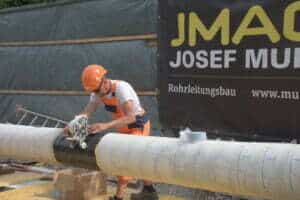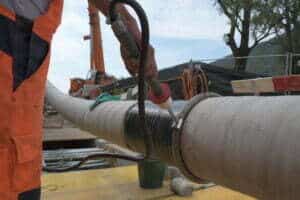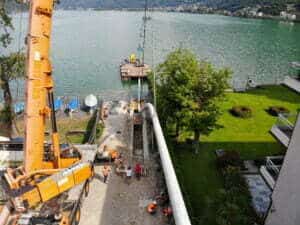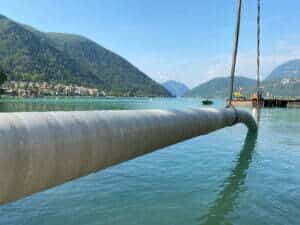Work on laying a 6 km long underwater gas pipeline made of steel pipes from Capolago to Bissone in Lake Lugano has been underway for around a year. This pipeline transports natural gas at a pressure of 5 bar and is being laid at the bottom of the lake. The aim of the project, which was initiated by Aziende Industriali di Lugano (AIL) SA, is to make the distribution of this important energy source to consumers in the Lugano and Mendrisiotto areas more efficient and safer.
A consortium of three specialized companies was formed to carry out the work on the underwater gas pipeline: Josef Muff AG is responsible for pipeline construction, Willy Stäubli AG is responsible for the marine work, and Comal.ch SA is acting as site manager.
The 6000 m long underwater pipeline is being built in meticulous individual steps. First, three individual strings of steel pipes, each 100 m long and with a diameter of DN 300, are welded together directly on the lakeshore. These 300 m long sections are then transported into Lago di Lugano via a rail system. The sections are transported by boat to the welding pontoon, where they are gradually welded together with the existing section and then lowered to the bottom of the lake. To ensure the safety of the underwater gas pipeline, pressure tests must be carried out every 100 meters. In addition, a 20 kV insulation test and mechanical protection of the pipeline prior to laying and lowering are essential.
One of the biggest challenges in laying the underwater gas pipeline was the geometry of the lake shore, especially when laying the 32 m long S-shaped initial section. As the water bed at Capolago is less than 10 m deep, a trench had to be dug for the first time in order to lay this section of the pipeline. The S-shaped section was welded together from two cold bends and had to be lifted at the correct angle and welded to the existing straight pipe section. It was crucial to swing the S-piece over the prepared trench in the lake without touching the ground or overloading the crane. At the same time, the boats on the lake had to balance the existing 400 m long pipeline, which was welded to the S-piece. This interaction between the boats and the crane required the utmost precision.
The underwater gas pipeline project is an outstanding example of Swiss engineering in energy infrastructure and combines technical innovation with environmental protection to secure the future gas supply in the region in the long term.



